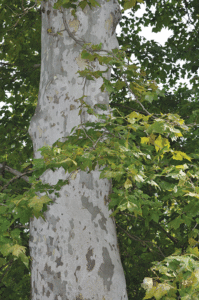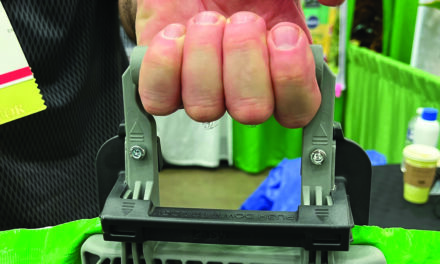
The sycamore tree’s bark is an interesting pattern of “patching” and shading. The creamy white base is covered in grayish brown patches giving the bark its distinguished look. (Photo courtesy Frank Caramanica)
When asked why she had not gotten a facelift at her age, Academy Award winning movie actress Bette Davis replied, “Because I have earned every line and wrinkle.”
The same can be said of the bark of trees. The tree has earned every line and curlicue.
The bark is the armor of the tree protecting the inner wood from disease, injury or illness.
This outer shield comes in a variety of patterns and colors.
The hues range from white and gray to orange, red, green or multiples of colors.
The texture can be smooth, rough, furrowed or can peel away revealing a tapestry of shades and textures.
Planning a design around the color and texture of tree bark provides a complete picture of a garden.
Choose flower colors, designs, heights and shrubs to enhance the tree bark and the garden will take on a new canvas of excitement.
Some common examples of these artistic beauties are the Sycamore, Dogwood, Hickory and River Birch.
The Sycamore tree bark is an interesting pattern of “patching” and shading.
It is often found near water or streams but does not require the wet soil to survive.
The creamy white base is covered in grayish brown patches giving the bark its distinguished look. The upper part of the trunk “exfoliates” into a patchwork of brown, yellow and green.
The Dogwood tree bark has small, compact, reptilian “scales.”
The small pattern and shading is most notable during late fall and winter.
The Hickory tree bark sports a very distinctive pattern.
Strips of bark pull away but remain attached to the trunk leaving unusual configurations.
The River Birch bark “peels” away. As the tree matures the loose curling bark is pressed into thick, irregular plates.
Once mature the River Birch scales become thicker towards the base of the trunk and are divided in deep furrows.
In a garden, trees with interesting bark should be limbed to reveal the design.
Use ground covers to reduce distractions from the bark. Tall, bright flowers or bushes will distract rather than focus the eye to the bark.
Plant trees in a line to enhance the display like a grouping of River Birch or Crepe Myrtles.
As strong and resolute as tree bark is, it can fall victim to the harsh fluctuation of temperature in winter and summer.
Avoid western exposures when planting new trees.
Red cedar and dogwood need part shade to full sun. When planting, dig as deep as the root and three times as wide.
In-fill with native soil. Look for adequate moisture and good drainage.
Fertilizer is not needed after planting but it is recommended watering be done twice a week during late summer unless there is sufficient rain.
Once cut or chipped, the bark, like skin, provides an avenue to the tender wood underneath.
Avoid making cuts with the weed-wacker or mower.
One solution is to plant a ground cover flowerbed around the base of the tree or fill with mulch.
The mulch should not exceed one or two inches deep as it will hold too much moisture and invite insect and rodent damage to the lower trunk and roots.
When beautiful, unique tree bark is incorporated in the design canvas of a garden the richness of colors and textures will provide years of artistic expression.




